View Products for Detoxification
If you answer “yes” to any of the following questions, from The Disease of Delusion, a book authored by Dr. Jeffrey S. Bland, that may be an indication of poor detoxification.
- Are you sensitive to fragrances and odors?
- What about food – any sensitivities?
- Are you sensitive to particular medications?
- Sensitive to alcohol?
- Do you get a bad reaction from monosodium glutamate in food?
- Do you have sensitivity to caffeine?
- Have you ever been sick from exposure to chemicals?
- Does cigarette smoke bother you or make you sick?
- Are you sensitive to smog or air pollution?
- Do you sometimes wake up in the morning feeling as if you’ve been drugged?
- Do you ever have unexplained skin rashes?
- Do you ever experience brain fog?
- Do you feel tingling in your hands or feet?
- Is there a consistent ringing in your ears?
- Do you experience unexplained muscle pain?
It may also be the case that “toxic experiences, relationships and thoughts” should be added to the above list. Author Deanna Minich, in her book, “Whole Detox,” says, “Every time you encounter an upsetting relationship, a frustrating personal situation, or a depressing day at work, your body is flooded with biochemical hormones that have the power to sabotage your health. I’m talking about stress hormones like cortisol, which cues your body to put on pounds, disrupt your sleep, and drive up your blood pressure, potentially sending you down the road to obesity, autoimmune conditions, and cancer. I’m talking about the shattering experience of heartbreaking grief, which research has shown can literally disrupt the workings of your heart. I’m talking about lives that seem plagued by loneliness and boredom, which numerous studies have shown are characterized by more chronic health problems and also end sooner than lives full of passion, meaning, and community.” This book is a must read!
Cellular Biotransformation
There is an enzyme super-system involving more than 50 different kinds of enzymes, each with its own gene (over 200 genes), called the cytochrome P450 system, CYP 450 for short. These are the main enzymes involved in Phase I of detoxification, where fat-soluble substances are made water-soluble. This super-system protects us against foreign xenobiotics from the outside world and from the toxic bacteria produced within our intestinal tracts, and it decontaminates the metabolic byproducts in cells and gets them ready for elimination from the body. (From The Disease of Delusion by Dr. Jeffrey S. Bland)
Mutations (genetic polymorphisms and SNPs) can result in increased, decreased or null activity in any of these over 200 CYP 450 genes. They also may decline with age, and inflammation has a tendency to decrease their activity, as will, cirrhosis of the liver.
The activity of the CYP 450 enzymes may be influenced (increased or decreased) by:
- Macronutrients, micronutrients, phytochemicals
- Medications
- Steroid hormones: glucocorticoids induce CYP3A4
- Peptide hormones: growth hormone induces CYP3A4
- Thyroid hormones: T3 inhibits CYP3A4
- Endotoxins
- Xenobiotics: industrial chemicals, pesticides, alcohol, environmental pollutants, cigarette smoke, food additives
- Fasting: induces many Phase I (especially CYP2E1)
Over 200,000 substrates must be processed by the CYP 450 system. Its complexity is overwhelming.
Phase II Conjugation
Phase II of the detoxification process involves another family of enzymes principally found in the liver, called conjugases. The Latin verb coniugo means to yoke together, so this phase is all about joining things. The conjugase enzyme takes the intermediate from Phase I, a now-nontoxic substance, and adds a chemical tail to it. A huge variety of tails can be added, but the conjugase will pick the one that’s right for the particular intermediate, and the result will be a substance that’s able to be transported into the blood and from there into the urine and stool more effectively. (From The Disease of Delusion by Dr. Jeffrey S. Bland)
Figure 1 illustrates the types of reactions that take place in Phase I and Phase II.
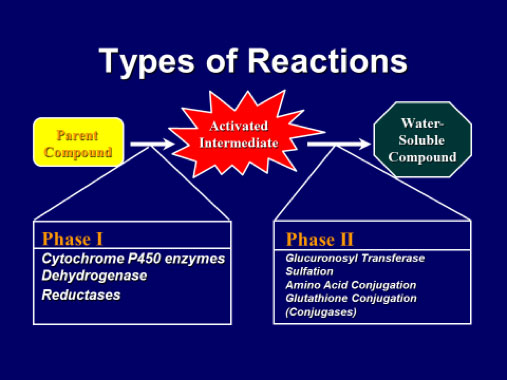
All tissues have some activity, but the majority of reactions occur in the liver. There is relatively high activity in GI tract, lungs, kidneys, and skin (all tissues have some).
Figure 2 illustrates what Phase I and II detoxification look like in and out of balance, while Figure 3 speaks to imbalanced detoxification.

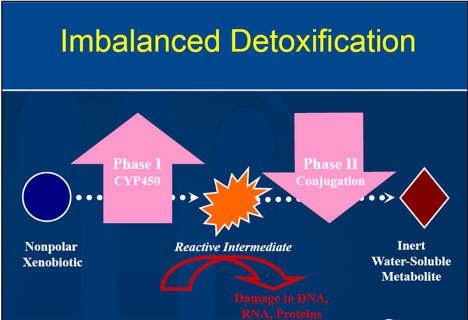
It’s important that Phase I and Phase II remain in balance. If Phase I exceeds Phase II, toxic chemicals accumulate and tissue damage occurs. These are very dangerous reactive oxygen intermediaries and it essential that adequate amounts of antioxidant-protective nutrients and plant derivatives are available to prevent tissue damage, like those listed below.
- Carotenes (Vit A)
- Ascorbic Acid (Vit C)
- Tocopherols (Vit E)
- Selenium
- Copper, Zinc
- Manganese, Coenzyme Q10
- Thiols (found in garlic, onions, cruciferous vegetables)
- Bioflavonoids
- Silymarin, Pycnogenol
Numerous nutrients are required for Phase I to function efficiently. The required nutrients are listed in Figure 4, with those in red being nutrients that are depleted by estrogen therapy.
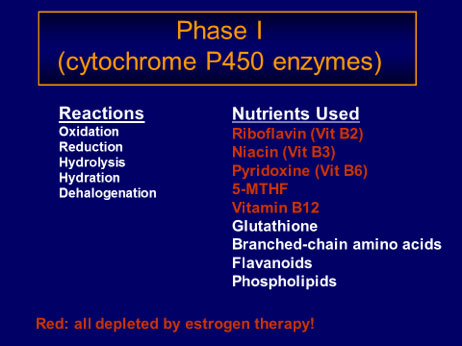
Numerous nutrients are also required for Phase II to conjugate the intermediates from Phase I efficiently, as noted in Figure 5.
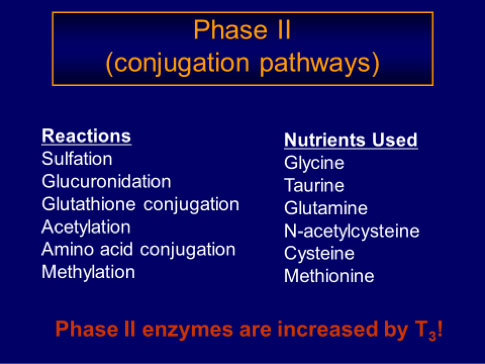
The reactions in Phase II are increased by the active thyroid hormone T3. There are numerous nutrients required to promote the conversion of T4 to T3, including:
- Iodine
- Iron
- Selenium
- Chromium
- Zinc
- Vitamin A
- Vitamins B2, B6, & B12
Keep in mind also that reverse T3 will inhibit the conversion of T4 to T3 and there are many factors that will increase reverse T3. (See Thyroid section.)
A micronutrient nutritional analysis is essential in evaluating the detoxification process!
Look at the many factors that impair the detoxification process.
Currently, more than 300 environmental chemicals or their metabolites are measured in human samples (e.g., urine, blood, serum, breast milk and meconium). (http://www.cdc.gov/biomonitoring/environmental_chemicals.html)
- Acrylamide
- Arsenic
- Benzene
- Benzophenone-3 (BP-3)
- Bisphenol A (BPA)
- Cadmium
- Chlordane and Heptachlor
- Cotinine
- Dichlorodiphenyltrichloroethane (DDT)
- Dioxins, Furans and Dioxin-Like Polychlorinated Biphenyls
- Disinfection Byproducts (DBPs)
- Mercury
- Methyl tert-Butyl Ether (MTBE)
- NNAL (4-(methylnitrosamino)-1-(3-pyridyl)-1-butanol)
- Organophosphorus Insecticides: Dialkyl Phosphate Metabolites
- Parabens
- Perfluorochemicals (PFCs)
- Polybrominated Diphenyl Ethers (PBDEs) and Polybrominated Biphenyls (PBBs)
- Polycyclic Aromatic Hydrocarbons (PAHs)
- Perchlorate
- Perfluorooctanoic Acid (PFOA)
- Phthalates
- Styrene
- Thallium
- Triclosan
http://www.cdc.gov/biomonitoring/chemical_factsheets.html
Persistent Organic Pollutants (Long-lasting Synthetic Chemicals)
Widespread production began of persistent organic pollutants, otherwise known as long-lasting synthetic chemicals, began less than 80 years ago; most were nonexistent before then. Detectible levels of dozens of them are found in the tissues of all living things on Earth.
What else do you need to know about these pollutants?
- Numerous opportunities for repeated exposure (oral, inhaled, topical) occur on a daily basis.
- They persist in the environment for years, even decades.
- They become airborne and travel long distances through the atmosphere and water supplies.
- They bio accumulate in fatty tissue.
- They create pathological detoxification by Phase I enzyme induction.
Organochlorine pesticides include DDT, dieldrin, aldrin and chlordane.
Industrial chemicals include PCBs and hexachlorobenzene.
Unintentional chemical byproducts include dioxins and furans.
Interested in learning more? Check out what the Stockholm Convention had to say about these pollutants at http://chm.pops.int/.
Commonly Encountered Xenobiotics
- Pollutants, industrial (dioxins)
- Petrochemical fuels (perchlorate) and solvents
- Pesticides (organophosphates)
- Plasticizers
- Perfluoro-octanes
- Pigments, paints, dyes and perfumes
- Preservatives and flame retardants (PBBs)
- Pharmaceuticals
More Interesting (and Scary) Facts About These Pollutants
- Since WWII, more than 85,000 new synthetic chemicals have been released into the environment.
- Less than 50% have been tested for potential toxicity to adult humans (and almost none for children).
- More than 4 billion pounds of pesticides are used annually in the U.S.
- Current law allows 350 different pesticides to be used on the food we eat.
- The average home contains 3-10 gallons of hazardous materials.
- Traces of more than 400 synthetic chemicals can be found in the human body.
Toxin Definitions
- Classical definition: a poison produced by a living organism that is active at low concentrations
- Popular definition: any substance that causes structural damage or functional disturbances
- Toxicants: toxic chemicals, typically those that have been introduced into the environment by humans (e.g., pesticides, pollutants)
- Xenobiotics: foreign substances (typically synthetic) found in the body that are not derived from a normal diet or produced endogenously (as per Robert Rountree, M.D.)
Impaired detoxification plays a major role in the issues cited earlier in this section. Image all these toxic chemicals, xenobiotics, normal metabolites, steroid hormones, and heavy metals all competing for the same CYP 450 and conjugate enzymes. If your total toxic load exceeds your ability to detoxify, there will be adverse health consequences.
How can you improve your detoxification system? Avoid all the chemicals listed above if possible. The proper diet is imperative. There are specific foods and beverages that contain phytochemicals know to support the genetic expression that regulates detoxification, including:
- Green tea, which contains catechins
- Tumeric, which contains curcumin
- Soy, which contains genistein
- Cruciferous vegetables, which contain glucosinolates
- Red grapes and Spanish peanuts, which contain resveratrol (in the skin of the peanuts)
- Watercress and pomegranate, which contain ellagic acid
- Hops, which contain humulones
(From The Disease of Delusion by Dr. Jeffrey S. Bland)
Supply the body with the micronutrients needed to optimize Phase I and Phase II of the detoxification system. Rid the body of heavy metals. Optimize the microbiome and prevent the overgrowth of pathogenic microorganisms. Improve excretion by improving bowel and renal function. Optimize cortisol, thyroid, insulin and hormone metabolism. Determine a way of dealing with upsetting relationships, frustrating personal situations, depressing days, loneliness and boredom. As mentioned earlier, read Deanna Minich’s book, Whole Detox.
Recommended Supplements to Address Detoxification:
ALA-Med CR (controlled release alpha-lipoic acid) is designed to neutralize free radicals. It has the ability to destroy free radicals in the water- and lipid-based portion of cells, making it the ideal whole-body antioxidant. In addition, ALA-Med CR helps the body synthesize glutathione, the body’s own master detoxifier.
Supports balanced detoxification (Phases I & II) and liver health and energy generation, promotes a variety of Phase II pathways, and supports natural antioxidant mechanisms.
Optimal methylation is required in Phase II detoxification. Supports healthy methylation of estrogen, dopamine, epinephrine, heavy metals, and environmental toxins.
Vitamin D deficiency is common among reproductive-aged women and has a role in female reproduction.
Selenium, copper, zinc and manganese are essential for neutralizing free radicals produced in Phase I detoxification.
Xeno Detox also supports antioxidant activity throughout the detoxification process.
Glutathione is your body’s most powerful antioxidant and detoxifying agent.
Supports detoxification of xenoestrogens.
A powerful antioxidant that is useful in detoxification.
Supports antioxidant and detoxification mechanisms.
Thyroid hormone plays a major role in Phase II detoxification.
Supports detoxification of environmental toxins and pollutants.
Supports detoxification and provides antioxidant protection.
Improves liver detoxification of chemicals, heavy metals and xenobiotics.
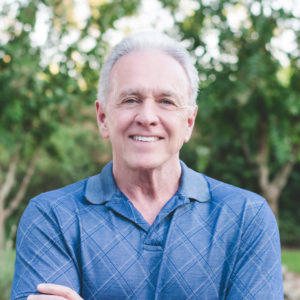
About the Author
Douglas C. Hall, M.D.
Dr. Douglas Hall, was born in Indianapolis, Indiana on Jan. 30, 1941. He received his BS and Doctor of Medicine at the University of Florida, training in obstetrics and gynecology. Dr. Hall has been in private practice since 1974 and currently has a large practice in Ocala, specializing in OB/GYN and Functional Medicine.

